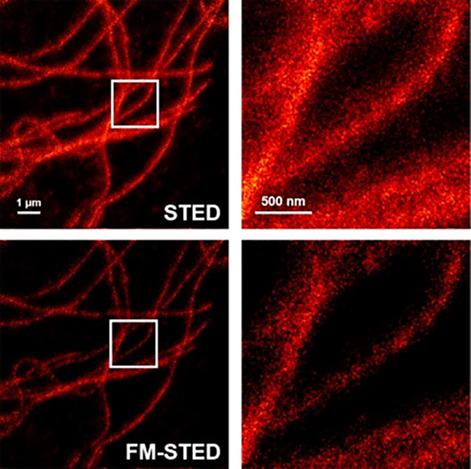当前位置:
X-MOL 学术
›
J. Biophotonics
›
论文详情
Our official English website, www.x-mol.net, welcomes your
feedback! (Note: you will need to create a separate account there.)
Improving the image quality in STED nanoscopy using frequency spectrum modulation
Journal of Biophotonics ( IF 2.0 ) Pub Date : 2020-12-13 , DOI: 10.1002/jbio.202000402 Jialin Wang 1 , Luwei Wang 1 , Jia Zhang 1 , Zhigang Yang 1 , Wei Yan 1 , Junle Qu 1
Journal of Biophotonics ( IF 2.0 ) Pub Date : 2020-12-13 , DOI: 10.1002/jbio.202000402 Jialin Wang 1 , Luwei Wang 1 , Jia Zhang 1 , Zhigang Yang 1 , Wei Yan 1 , Junle Qu 1
Affiliation

|
Since stimulated emission depletion (STED) nanoscopy was invented in 1994, this technique has been widely used in the fields of biomedicine and materials science. According to the imaging principle of STED technology, increasing the power of the depletion laser within a certain threshold can improve the resolution. However, it will cause not only severe photo‐damage to the samples and photo‐bleaching to the fluorophores but also serious background noise, leading to the degeneration of the quality of STED images. Here we propose a new processing method based on frequency spectrum modulation to improve the quality of STED images, abbreviated as FM‐STED. We have demonstrated the performance of FM‐STED in improving the signal‐to‐noise ratio and the resolution using fluorescent beads and biological cells as samples.
中文翻译:

使用频谱调制提高STED纳米显微镜的图像质量
自从1994年发明了激发发射耗尽(STED)纳米技术以来,该技术已广泛应用于生物医学和材料科学领域。根据STED技术的成像原理,在一定阈值内增加耗尽激光器的功率可以提高分辨率。但是,这不仅会导致严重的样品光损伤和荧光团的光漂白,还会导致严重的背景噪声,从而导致STED图像质量下降。在这里,我们提出了一种基于频谱调制的新处理方法,以提高STED图像的质量,简称为FM-STED。我们已经证明了FM‐STED使用荧光珠和生物细胞作为样品在提高信噪比和分辨率方面的性能。
更新日期:2020-12-13

中文翻译:

使用频谱调制提高STED纳米显微镜的图像质量
自从1994年发明了激发发射耗尽(STED)纳米技术以来,该技术已广泛应用于生物医学和材料科学领域。根据STED技术的成像原理,在一定阈值内增加耗尽激光器的功率可以提高分辨率。但是,这不仅会导致严重的样品光损伤和荧光团的光漂白,还会导致严重的背景噪声,从而导致STED图像质量下降。在这里,我们提出了一种基于频谱调制的新处理方法,以提高STED图像的质量,简称为FM-STED。我们已经证明了FM‐STED使用荧光珠和生物细胞作为样品在提高信噪比和分辨率方面的性能。











































 京公网安备 11010802027423号
京公网安备 11010802027423号